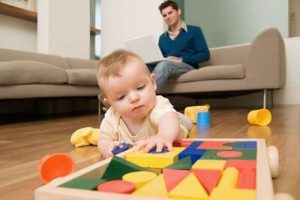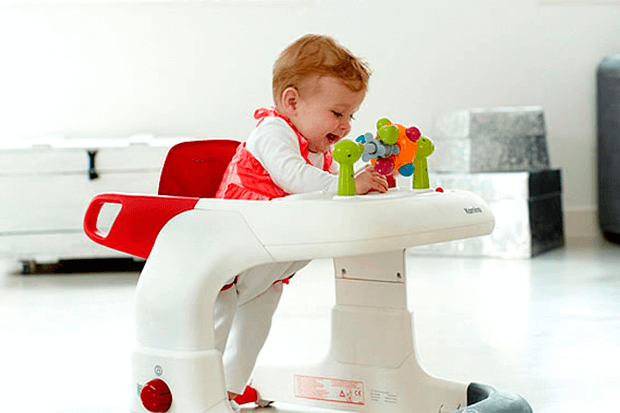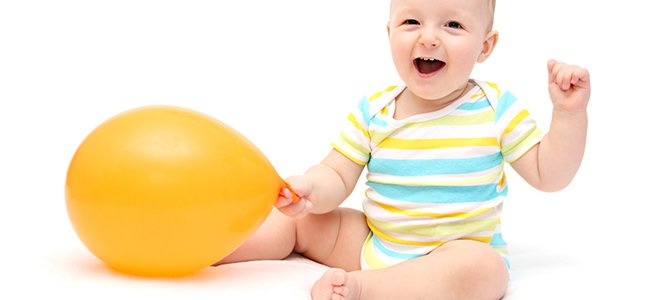9 Mistakes to Avoid when Your Child is Learning to Walk

The stimulation a child needs for development varies from one stage to the next. Some stages require less stimulation than others, yet all are important. For example, prenatal stimulation can sometimes be left out altogether when children are learning to walk.
During other stages of infancy, stimulation also goes unnoticed. However, sometimes it is better to overlook stimulation than to go about it the wrong way.
During development, children are capable of learning many things on their own. They can accomplish certain tasks or goals with little or no outside assistance.
Even so, it’s always important for children to have the support and encouragement of their parents. Mom and dad’s presence during each stage of learning should be comprehensive and full of patience.
Stimulation is important in order for children to have an adequate development. This includes giving children access to the tools needed to adapt to their surroundings.
However, there are some things that parents should avoid. Sometimes parents may make the mistake of going overboard. Over-stimulation is not good for children, nor are certain specific methods of stimulation.
Mistakes to avoid when children are learning to walk
Parents are all free to choose the way they raise their children. However, specialists have determined that we sometimes make mistakes that really should be avoided.
It is believed that the most common mistakes in stimulation occur when a child is learning to walk. To be sure that our little ones are not affected by our bad habits, we should take the time to examine and consider the following recommendations.
Don’t force it
Avoid taking your child by the hand to “help” her to walk. It’s better to encourage her to walk on her own. This will lead to autonomy in the future. You should never force your children to walk when they don’t want to or aren’t ready. It’s vital that your child move about as she prefers.
Avoid being afraid of everything
It’s important to allow your child to get to know his new ability. We should accompany our children without pressuring them. Your child should never feel overwhelmed by excessive expectations or fears.
Using a walker

Using a walker when your child is learning to walk can actually delay the point in which he feels comfortable walking without any support. Furthermore, using a walker can have long-term consequences, including structural alterations in your child’s legs and feet. Walkers are also known to be one of the principle causes of accidents in the home.
Shoes for walking
Babies’ feet don’t need the support of rigid shoes. On the contrary, babies should go without shoes as much as possible. According to experts, the soles of a child’s feet are still developing at the time he or she starts learning to walk. Therefore, rather than helping, we can actually be doing harm by putting shoes on our infant’s feet.
If you prefer your child uses shoes, it’s still best that you take them off when your child is walking. The shoes your child uses should have flexible soles. Remember that their function should only be to keep your child from slipping and to protect from possible injury. Shoes that obstruct the formation of the foot’s arch can cause your child to lose stability when walking.
Over-stimulation
It’s common for parents to use toys to stimulate their babies to walk. However, you need to be careful not to interfere with your baby’s ability to concentrate on the task. The toy you choose for your child should be something he can play with, and nothing more.
This can be a toy or some other object that doesn’t pose any danger and can be used as a single focal point. You should be careful not to overstimulate your baby with various objects at once. You should also stay away from toys with flashing lights or loud noises that may be too stimulating for your little’s one’s senses.
The location of mobiles can be useless
When it comes to decorating the baby’s room, some parents have the custom of hanging mobiles in the wrong place. If you hang a mobile next to the crib or play pen, or if you hang it too high, it loses its usefulness.
The correct place to hang a mobile is over the center of the crib. It should be at a distance that allows your child to concentrate on being able to reach it. This will motivate your baby to move around, and will prevent alterations in the posture of her neck.
Sitting your baby without support

If your child can’t sit up on his own, then he should have the correct support when seated. It’s very common for parents to sit their children leaning against pillows before the age of 5 months.
This can be very dangerous as their bodies are not capable of maintaining this position. You could actually cause your child to lose his muscular activation by placing him in positions that are inappropriate for his stage in development.
Running ahead of your child
Many parents try to motivate their children to walk by having their children chase them. As the child advances, the parent moves further and further away so the child has to continue walking. This isn’t bad, of course, but you shouldn’t move away if your child is just about to reach you.
In other words, if your child is walking and is just about to catch up with you, you should let him reach his goal. This will keep your child from becoming frustrated. If you continue to move away when he catches up to you, he won’t want to continue playing.
Walking with arms raised in the air
The correct way to support your baby while she walks is to place your hands just below her armpits or at pelvis level. Expects recommend this in order to allow your child to walk naturally. No one walks with their arms raised in the air, so it’s best not to teach your child to walk in that position.
The stimulation a child needs for development varies from one stage to the next. Some stages require less stimulation than others, yet all are important. For example, prenatal stimulation can sometimes be left out altogether when children are learning to walk.
During other stages of infancy, stimulation also goes unnoticed. However, sometimes it is better to overlook stimulation than to go about it the wrong way.
During development, children are capable of learning many things on their own. They can accomplish certain tasks or goals with little or no outside assistance.
Even so, it’s always important for children to have the support and encouragement of their parents. Mom and dad’s presence during each stage of learning should be comprehensive and full of patience.
Stimulation is important in order for children to have an adequate development. This includes giving children access to the tools needed to adapt to their surroundings.
However, there are some things that parents should avoid. Sometimes parents may make the mistake of going overboard. Over-stimulation is not good for children, nor are certain specific methods of stimulation.
Mistakes to avoid when children are learning to walk
Parents are all free to choose the way they raise their children. However, specialists have determined that we sometimes make mistakes that really should be avoided.
It is believed that the most common mistakes in stimulation occur when a child is learning to walk. To be sure that our little ones are not affected by our bad habits, we should take the time to examine and consider the following recommendations.
Don’t force it
Avoid taking your child by the hand to “help” her to walk. It’s better to encourage her to walk on her own. This will lead to autonomy in the future. You should never force your children to walk when they don’t want to or aren’t ready. It’s vital that your child move about as she prefers.
Avoid being afraid of everything
It’s important to allow your child to get to know his new ability. We should accompany our children without pressuring them. Your child should never feel overwhelmed by excessive expectations or fears.
Using a walker

Using a walker when your child is learning to walk can actually delay the point in which he feels comfortable walking without any support. Furthermore, using a walker can have long-term consequences, including structural alterations in your child’s legs and feet. Walkers are also known to be one of the principle causes of accidents in the home.
Shoes for walking
Babies’ feet don’t need the support of rigid shoes. On the contrary, babies should go without shoes as much as possible. According to experts, the soles of a child’s feet are still developing at the time he or she starts learning to walk. Therefore, rather than helping, we can actually be doing harm by putting shoes on our infant’s feet.
If you prefer your child uses shoes, it’s still best that you take them off when your child is walking. The shoes your child uses should have flexible soles. Remember that their function should only be to keep your child from slipping and to protect from possible injury. Shoes that obstruct the formation of the foot’s arch can cause your child to lose stability when walking.
Over-stimulation
It’s common for parents to use toys to stimulate their babies to walk. However, you need to be careful not to interfere with your baby’s ability to concentrate on the task. The toy you choose for your child should be something he can play with, and nothing more.
This can be a toy or some other object that doesn’t pose any danger and can be used as a single focal point. You should be careful not to overstimulate your baby with various objects at once. You should also stay away from toys with flashing lights or loud noises that may be too stimulating for your little’s one’s senses.
The location of mobiles can be useless
When it comes to decorating the baby’s room, some parents have the custom of hanging mobiles in the wrong place. If you hang a mobile next to the crib or play pen, or if you hang it too high, it loses its usefulness.
The correct place to hang a mobile is over the center of the crib. It should be at a distance that allows your child to concentrate on being able to reach it. This will motivate your baby to move around, and will prevent alterations in the posture of her neck.
Sitting your baby without support

If your child can’t sit up on his own, then he should have the correct support when seated. It’s very common for parents to sit their children leaning against pillows before the age of 5 months.
This can be very dangerous as their bodies are not capable of maintaining this position. You could actually cause your child to lose his muscular activation by placing him in positions that are inappropriate for his stage in development.
Running ahead of your child
Many parents try to motivate their children to walk by having their children chase them. As the child advances, the parent moves further and further away so the child has to continue walking. This isn’t bad, of course, but you shouldn’t move away if your child is just about to reach you.
In other words, if your child is walking and is just about to catch up with you, you should let him reach his goal. This will keep your child from becoming frustrated. If you continue to move away when he catches up to you, he won’t want to continue playing.
Walking with arms raised in the air
The correct way to support your baby while she walks is to place your hands just below her armpits or at pelvis level. Expects recommend this in order to allow your child to walk naturally. No one walks with their arms raised in the air, so it’s best not to teach your child to walk in that position.
All cited sources were thoroughly reviewed by our team to ensure their quality, reliability, currency, and validity. The bibliography of this article was considered reliable and of academic or scientific accuracy.
- Cabrera, M.C. y Sánchez C. (1982). La estimulación precoz; un enfoque práctico. Editorial Siglo XXI: España.
- Dorance, S. y Matter, P. (2001). Juegos de estimulación para los más pequeños. Madrid: AKAL.
- Gallahue, D. (1982). Understanding motor development in children. New York: John Wiley and sons.
- Guerrero, A. M., & Primaria, I. Y. (n.d.). La estimulación temprana. https://archivos.csif.es/archivos/andalucia/ensenanza/revistas/csicsif/revista/pdf/Numero_14/AMALIA_MORENO_1.pdf
- Moreno, J. A. (1999). Motricidad infantil. Aprendizaje y desarrollo a través del juego. Murcia: Diego Marín.
- Moreno, J. A., & De Paula, L. (2006). Estimulación de los reflejos en el medio acuático. Revista Iberoamericana de Psicomotricidad y técnicas corporales, 6(2), 193-206. https://www.um.es/univefd/reflejos.pdf
- Ordoñez, M. y Tinajero, L. (2012). La importancia de la estimulación temprana en la etapa infantil. Madrid, 208-240.
This text is provided for informational purposes only and does not replace consultation with a professional. If in doubt, consult your specialist.








